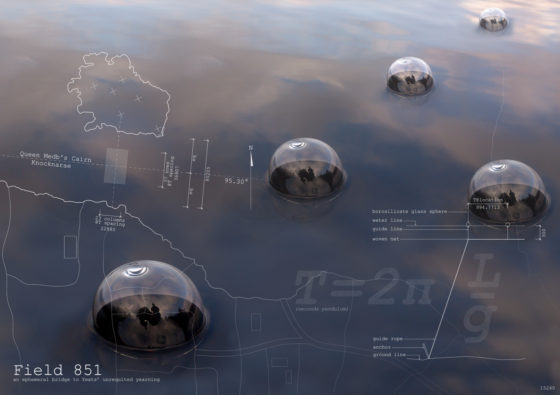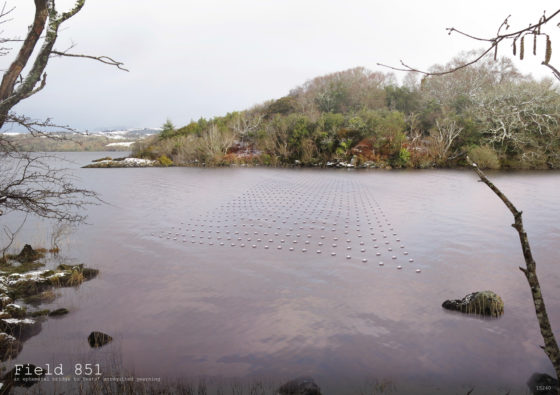“Field 851…. uses a very specific method of construction to reference contemporary architectural idiom. The grid or ‘field’ of 851 borosilicate glass spheres is derived from the golden mean relationship between two prime numbers, 23 by 37. The spacing between each sphere is the length of a ‘seconds pendulum’ calculated using the site-specific gravity of Sligo. Borosilicate glass was chosen for its strength and resistance to weather and heat, clarity of light transference, and reference to early metaphysical laboratory experiments.”
Field 851 was a conceptual response in collaboration with Kevin O’Brien Architects, to the Yeats 2015 open submission architectural competition calling for an artistic intervention to be placed on or around the lake isle of Innisfree.
“Arriving at the jetty, you take in the view across the water to where Innisfree island sits like an upturned birds nest resting on the horizon. There’s no sign of any ‘architectural mediator’ from this vantage, and you long for a vessel to appear out of the mist and transport you across to the mythical island. But nothing appears, and after looking again for any signs of sculptural protuberance from the tree line, you are resigned to seeking other distractions on this changeable day of wet wind and balmy calm. As you turn to go now, a glint of light catches your eye, and something glimmers in the distance between the rocky highland and the tiny island, like the spark between outstretched fingers on an ancient chapel ceiling.
Intrigued, you make your way along the shoreline, winding down an overgrown path bordered by young broad-leafs, and through the leaves you see in the water what can only be described as a ‘field’ that appears and disappears, like a glitch in the matrix, like a momentary arising of the Akasha. You wonder if it is caused by the tension existent between the island and the mainland, like the static electric when two masses get close enough, like the atomic experiments at CERN.
You round the corner, out of the woods, and realize these shifting patterns in the sloe-blue water arise from an array of hundreds of clear glass bubbles that collect and reflect their surroundings. Sitting down on the bench by the waterside, you contemplate this ephemeral glass bridge of floating steppingstones. It will bring you closer to the island, but only in the world of thought, of dream. Is it simply a moving mirror, a reflection of my consciousness, like thoughts and ideas always dancing across my mind? So you sit there and ponder this fugitive field, and begin to hear the sound of water lapping, and in the stillness of evening the glass spheres are reflections in a pool and you are transported.
Yeats’ poem The Lake Isle of Innisfree is an unfulfilled longing for an idealized natural existence, and a mirror of his inner spiritual world. While looking at his reflection on a busy street he sees two layers of his existence overlapping in a shop window. His physical body is in the urban construct, while his ‘core’ is in Sligo. He is in London, among other things, to study the occult, metaphysics and paranormal activity as a founding member of the Hermetic Order of the Golden Dawn.
Field 851 is based on these three aspects of Yeats (reflection, longing, and metaphysics) and uses a very specific method of construction to reference contemporary architectural idiom. The grid or ‘field’ of 851 borosilicate glass spheres is derived from the golden mean relationship between two prime numbers, 23 by 37. The spacing between each sphere is the length of a ‘seconds pendulum’ calculated using the site-specific gravity of Sligo. The Pendulum features highly in the world of occult. Borosilicate glass was chosen for its strength and resistance to weather and heat, clarity of light transference, and reference to early metaphysical laboratory experiments.
When assembled and placed floating in the water, Field 851 functions on many levels. It collects, magnifies and reflects, amplifying the conditions of all things present. As it rises out of the lake, Field 851 manifests as a small part of ‘the fabric of the universe’ or ‘the Akashic field of infinite possibility’ creating Yeats’ duality: physical/spiritual, urban/rural, natural/construct. In calm conditions Field 851 is geometric and regular, but as the wind blows and the water starts to move, it becomes more organic in nature, constantly moving between these two states in response to the universal forces acting upon it.
Field 851 is an ephemeral bridge to Yeats’ unrequited yearning.”
Graham Reid
Date: 2015
Dimensions: L: 36.81 meters W: 22.88 meters H: 0.3 meters
Materials: Borosilicate Glass, Natural Fibre, stainless steel anchors.

